HS2 metaverse will let engineers put on a virtual reality headset to fix faults
A ‘metaverse’ of HS2, England’s upcoming high-speed railway line, will let engineers put on a virtual reality (VR) headset to fix faults.
HS2 Ltd, the state-funded body responsible for delivering the line, is planning to pack train tracks, overhead power lines and bridges with sensors.
Similar to those used in Formula One and aviation, the sensors will detect issues and beam data back to a 3D digital replica at a nearby control centre.
About 50,000 sensors will be built into the infrastructure of HS2 by the time construction of the first high-speed rail line is complete, according to experts.
HS2, which is estimated to cost more than £100 billion overall, aims to provide a high-speed rail service linking London and northern England.
The first ‘phase’ of the line, between London and Birmingham, is expected to open between 2029 and 2033.
A ‘metaverse’ of HS2, England’s upcoming high-speed railway line, will let engineers put on a virtual reality (VR) headset to fix faults. Pictured are workers in one of the two tunnels at the south portal HS2 align compound, in Rickmansworth, Hertfordshire
The data that sensors on board the high speed trains collect will be transmitted directly to HS2’s Birmingham-based Network Integrated Control Centre (NICC) at Washwood Heath, about two miles north-east of Birmingham city centre.
Workers will be able to don a headset to keep an eye on the HS2 digital replica, which will have as much detail as its real-life counterpart.
‘They will see a virtual representation of the real world’, David White, head of strategic planning and asset management on HS2, told the Times.
‘Anything with a sensor on it will have data on its condition fed into the VR version of the railway and can be observed via the headset.’
At a given section of the London to Birmingham track, an antenna on top of the trains will receive data from sensors on the train track, bridges and power lines.
This data will then get beamed to a tall signalling mast and sent to the control centre via a superfast 5G signal to continually update the digital replica in real time.
Once an issue is detected, HS2 workers will be able to send out teams to fix the issue at the site.


The first ‘phase’ of the line, between London and Birmingham, is expected to open between 2029 and 2033. Artist’s impression of an HS2 train
Alternatively, some problems could be solved by a quick fix that doesn’t require a team to be deployed – such as simply turning off power with the flick of a switch at the control centre.
‘Our plan is to reduce the amount of time that our staff have to go outside,’ said White.
‘At night on normal railways, you have to go through quite a lot of processes to turn the catenary [system of overhead wires] off, especially in tunnels, which adds a huge amount of time to the start of the maintenance activity.
‘So if you can eliminate some of that you’re really giving a lot more back to the maintainer to do the work they need to and then release the space back to the train operator.’
HS2 will also use machine learning, a form of artificial intelligence (AI), to predict faults before they happen.


It’s Meta’s ambition to transform into a ‘metaverse’ – a collective virtual shared space featuring avatars of real people, accessible with an internet connection and virtual reality headset (stock image)
Information on previous faults will be analysed by the company’s machine learning tool in order to predict where future faults are most likely to occur.
‘The idea is that the AI gets more experienced as time goes on, and will understand how things have failed in the past and determine when assets are likely to fail,’ White said.
‘Digital twins’ of infrastructure used for maintenance purposes goes back several years, but more and more firms are opting to view them in a virtual internet-connected reality with their own avatars – a concept known as the ‘metaverse’.
Interest in metaverses suddenly surged last autumn when Mark Zuckerberg re-branded his company from ‘Facebook’ to ‘Meta’ as part of a new focus on the metaverse concept.
The term ‘metaverse,’ coined in the 1992 dystopian novel ‘Snow Crash,’ is used to describe immersive, shared spaces accessed across different platforms where the physical and digital converge.
Zuckerberg has described it as an ’embodied internet.’
HS2 said its digital replica will be different from Meta’s vision of the metaverse, as workers won’t have avatars and will just put on headsets to inspect the route.
